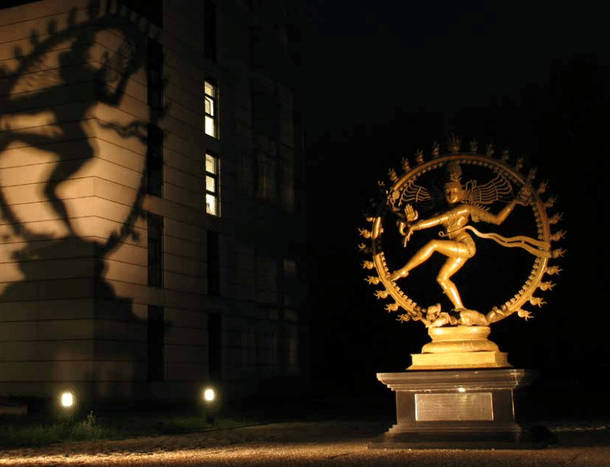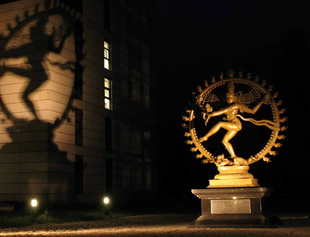Magazine
The Case Of The Dancing Shiva
Aravindan Neelakandan
May 10, 2016, 05:29 PM | Updated 05:29 PM IST
Save & read from anywhere!
Bookmark stories for easy access on any device or the Swarajya app.


The engagement of Hindutva with science has been marked by some very significant milestones for the science and technology of the previously colonized nations and cultures. Nevertheless the media characterization—and to a very significant extent academic study—of this engagement has been partial and biased against Hindutva. The reason is not far to seek. Hindutva has also built in public space a strong cargo cult presence with regard to science. With the era of digitalized memes, making this face of Hindutva ever so visible to the public psyche, it also provides its detractors a golden opportunity to reinforce their critique that Hindutva is anti-science.
(Cargo cults: The term originates from New Guinea, where waiting for ships or planes to bring dead ancestors and cargo began as a religious tradition in the 1910s. The natives mimic the entire operation of radio communication of the planes with wooden replicas and await the arrival from the sky of the cargo as well as their promised leader.)
Here are some specific instances of cargo cult Hindutva:
• In 2009, the Tamil Nadu branch of the Vishwa Hindu Parishad (VHP) launched its web TV. In one of its first webcasts, it claimed that a stone carving found at a village in Tamil Nadu, which was claimed to be a yantra dedicated to Shani, the deity of Saturn—resembles the design of the polar region of Saturn—the planet—that NASA’s Cassini spacecraft had photographed.
Fact check: The hexagonal weather pattern around the north pole of Saturn has nothing to do with the yantra for the deity of the planet venerated by Hindus. The latter is essentially a star enclosed in a lotus pattern which remotely resembles the Saturn weather formation.
• Anyone who goes through the Hindu forums on the Internet would be struck by similar claims—absolutely unscientific and pseudo-scientific fabrications—which often go viral with the “true believers”. NASA satellites stopping over a temple in the village of Thirunallar in Tamil Nadu is one such example. Then we have the completely fantasy-based narrative about why a statue of Nataraja was installed at CERN, the European Organization for Nuclear Research, which operates the world’s largest particle physics laboratory. This viral meme claims that the world faced the threat of apocalypse due to CERN’s experiment to discover the till-then-theorized Higgs boson, popularly known as the God Particle. Scientists around the world were terrified. Dr A.P.J. Abdul Kalam then came to the rescue and proposed that invoking Lord Nataraja would avert the wrath of the gods. So the two-metre-high bronze statue symbolizing Shiva’s cosmic dance of creation and destruction was installed. These memes get shared in thousands if not millions.
Fact check: The truth is that the statue was a 2004 gift—four years before the experiment began—from the Indian government to celebrate CERN’s long association with India, with no connection to any fear of pralaya—the end of the universe. Rather it is related to Indologist Ananda Coomaraswamy’s famous article, The Dance of Shiva, and subsequent use of the imagery by physicist-author Fritjof Capra.
• The March 2007 issue of a Hindutva monthly Hindu Voice ran a story that a National Geographic Society team, in collaboration with the Indian Army, had dug up a giant human skeleton “in the northern region of India”. Titled Bhima’s Son Gadotkach-Like Skeleton Found, the article also claimed that the exploration team had discovered inscriptions stating that Brahma had created a race of super-humans.
Fact check: According to the National Geographic Society website, Hindu Voice editor P. Deivamuthu admitted that his publication was taken in by fake reports. The magazine published a retraction after readers alerted the editor to the hoax.
• Cargo cult Hindutva takes an ominous form when it claims that the Hindu gotra system has the eugenic aim to “eliminate all recessive defective genes from the human DNA.” A widely distributed article titled Genetics Behind Hindu Gotra System claims that an understanding of Y-chromosome-based male inheritance was behind the devising of the system and that “through the Gotra system, Y chromosome came all the way down over thousands of years of timespan from the particular Rishi.”
Fact check: While pioneering Hindutva ideologue of modern times, Vinayak Damodar (Veer) Savarkar had decisively rejected any claim to genetic purity by any human group and had called caste system a ‘failed’ experiment, and that even Vedic texts show that the gotra related to seers need not represent bloodlines. Rishi Viswamitra brought Shunashepa, belonging biologically to another gotra, into his own, and expelled his own sons who objected to this admission of Shunashepa.
There is also ‘Vedic’ mathematics, which is neither Vedic nor mathematics. Then there is the persistent obsession with ancient flying machines and nuclear weapons supposedly used in the wars described in our epics. A treatise on aeronautics attributed to an ancient sage Bharadwaj was apparently downloaded through “psychic channeling” during the years 1918-1923, and since then Bharadwaj has been projected in much Hindu propaganda literature as the father of aeronautics.

All these have given the critics of Hindutva valuable ammunition and justifiably so. Superficially, the juvenile need to find all modern scientific and technological achievements in ancient Hindu civilization and scriptures looks very much like the theo-politically motivated pseudo-science of Intelligent Design (ID)/Creationism—which denies evolution—that is very much a part of the Western religious right wing package. However, there is an important distinction.
Molecular biologist Paul F. Lurquin and anthropologist Linda Stone, in their book Evolution and Religious Creation Myths (Oxford University Press, 2007), have some explicitly wrong interpretations of certain core Hindu concepts. Brahman is called the “creative principle” by the authors—an obvious confusion with Brahma the creator god of Hindu mythology. Atman is termed “universal spirit” instead of the individual consciousness. Nevertheless, the following passage brings out the vital distinction between the Hindutva discourse and that of Western right-wing fundamentalism:
“The BJP is an ultra-nationalist movement whose aim is to show and teach the ascendancy of all things Hindu, from history to science. In particular, the BJP advocates the development of ‘Vedic Science’ based on the posited scientific superiority of Hindu sacred traditions… Also, the BJP does not advocate ID or anything like it. The BJP has not singled out the theory of evolution as a threat to Hindu values. Hindu fundamentalism, then, is not interested in detracting science (including evolution) or proving it wrong but in integrating Vedic and Hindu traditions within the main body of science. This may reflect the enormous power of syncretism in Hinduism.”Paul F. Lurquin and Linda Stone in Evolution and Religious Creation Myths
This is a significant difference between Hindutva and Western right-wing fundamentalism. And in this difference lie the possibilities for the Hindutva movement to forge positive and healthy relations for the dialogue between science and Indic culture and philosophical traditions. The reason and nature of Hindutva cargo cult memes which are a grotesque invention of fantasies need to be understood in the context to proceed further.
In cultural anthropology, cargo cults are symptoms of a deeper longing. At first sight, the whole business looks childish and superstitious. But anthropologist Marvin Harris, in an insightful study Cows, Pigs, Wars and Witches: The Riddles of Culture (Random House, 1976), pointed out that the cult actually carried within it a deeper criticism of global unequal distribution of wealth:
“This would be a cogent theory if there were nothing mysterious about how industrial wealth gets manufactured and distributed. But in point of fact, it is not easy to explain why some countries are poor and others rich, nor is it easy to say why there are such sharp differences in the distribution of wealth within modern nations. What I’m suggesting is that there is really a cargo mystery, and that the natives are justified in trying to solve it.”Marvin Harris in Cows, Pigs, Wars and Witches: The Riddles of Culture
The invention of the fantasy-filled narrative on why the Nataraja statue was installed at CERN, connecting it with the God Particle and protecting the world from annihilation, or the NASA Saturn yantra discovery, or the stopping of satellites by a mysterious ray above a particular temple… all these are equivalents of the cargo cult.
There is unquestionably an Indic-Asian contribution to the generation of knowledge and there is space for dialogue for Indic philosophical systems with the core questions that move the finest human minds towards probing the mysteries of the universe. But in the last seven decades, the institutions of the State have consistently denied any such healthy dialogue in the name of secularism.
Left-wing radical propaganda, the Dravidian pseudo-rational movement, and so on, have either reduced Hindu philosophy to the determinism of production relations or worse, to racial interpretations of the lowest kind.
Let us consider the imagery of Shiva as the dancing Nataraja.
Since Coomaraswamy popularised the image, it has become a symbol of the dynamic nature of existence being continuously discovered by various material sciences. Particle physicist Fritjof Capra’s bestseller The Tao of Physics (1976), exploring the parallels between modern physics and mysticism, used a photomontage of Nataraja and images of trajectories of particles in a bubble chamber.

Nobel laureates Ilya Prigogine and Philippe Glansdorff used a Nataraja image on the cover of their book Thermodynamic Theory of Structure Stability and Fluctuations (1978) to symbolize the centrality of non-equilibrium thermodynamics in nature.
For V.S. Ramachandran, the neurologist, the dance of Shiva provides the metaphor for placing an individual in the grand show of evolution—accepting one’s life and death as part of the movements of the great dance (Phantoms of the Brain, 1999).
Yet, in Tamil Nadu, the icon was crudely criticized by the so-called rationalists of the Dravidian movement. Ironically, the racist social movement which prided itself as rationalist was itself based on pseudo-scientific colonial axioms of separate Aryan and Dravidian races. In the name of ‘rationalism’, it transformed the symbol of Nataraja into a literal rendering and made a cruel caricature.
A famous Dravidian propaganda poster of the early 1970s shows an American astronaut descending on the crescent adorning the head of the dancing Shiva. There is much irony here. Throughout the world, it is usually fundamentalists who resort to literal interpretations of the scriptures. But in India, the so-called rationalists are the most eager to do what the fundamentalists do elsewhere: take the literal meaning of symbols and create criticisms. And the so-called believers often speak of their deities as symbolic rather than literal.
Unfortunately, the entire Indian educational system has a deeply inbuilt aversion to Indian symbols that have the capacity to harmonize science, philosophy, art and aesthetics. It is this rejection—the denial of a healthy dialogue between science and philosophical systems of India—that is the reason for the cargo cult caricatures inventing such fabulously nonsensical narratives involving Shiva, the God Particle and world destruction.
It is not that the Hindu movement does not have the history or the capacity to engage in such a dialogue. Even during colonial times, India produced a comprehensive historiography of science that challenged the Eurocentric nature of the prevalent science history narrative. One just has to go through the pages of Acharya Prafulla Chandra Ray’s (1861-1944) voluminous A History of Hindu Chemistry (1903).
Ray was also an eminent chemist of international calibre. Apart from about 200 original papers published in The Journal of Chemical Society (London), he was the first to synthesize mercurous nitrite. It was his work that established that nitrites were stable substances contrary to the dominant view that they were unstable. His demonstration that ammonium nitrite is indeed stable was highlighted by Nature (15 August 1912). Motivated by French chemist-politician Marcellin Berthelot, he wrote his monumental work on Hindu chemistry.
The work can rightly be considered the concretization of the Hindu civilizational tryst with the discourse of science that was initiated in modern times by Swami Vivekananda. It was neither just a collection of facts nor vain glorification. It was a critical study taking into account the dynamics of social evolution and its role in shaping the way institutions of science emerge. Acharya Ray sharply criticizes the Eurocentric attitude in weaving the history of science that had a clear agenda of establishing western superiority. The tendency of colonial historiographers to impute Greek origins to many Indic scientific discoveries is carefully analyzed by Ray:
“It is curious to reflect that the upholders of the ‘Greek Culture’ are often found ready, though unconsciously, to twist and torture facts and conclusions to serve their own purpose, and reserve to themselves the benefit of doubt as regards date: but whenever the priority of the Hindus is unquestionable, an appeal is made to the theory of common origin and independent parallelism of growth. These scholars seem to smart under a sense of injury if they have to confess that Europe owes an intellectual debt to India, hence many a futile attempt to explain away positive historical facts.”Acharya Ray
Interestingly, he also had to tackle certain questions bordering on the cargo cult in his own times. It was the question of ancient “missile technology”. Even today the fertile imagination of Indian epic writers regarding the weapons of ancient wars provides ‘proofs’ of ancient nuclear technology. The notorious documentary series Ancient Aliens on the History Channel peddles such fantasies which simply get recycled. This is worse than cargo cult. It is gross commercialization of pseudo-scientific sensationalism. Subsequently, this western distortion is carefully omitted and in academic studies on Hindutva, the movement and ideology get strongly identified with such crackpot delusions.
Yet, as early as 1902-3, Acharya Ray had dismissed any attempt made then to read any prevalent technologies of the times in the weaponry of the epics:
“In Sanskrit literature, there are frequent but vague references to ‘agni astra’ or firearms, but we have no reason to suppose that the combustible matter these firearms contained supplied a motive power of the nature of the gunpowder. The fire missiles were probably of the same category as the flax, resin, naphtha or other bituminous substances discharged from bows…But there is nothing to show that gunpowder of any sort was in use or any chemical which would act as a propelling agent.”Acharya Ray
Acharya Ray is one of the first significant initiators in modern times, from the Hindu side, of a dialogue with science as a historical and human phenomenon. This is a legacy that has often been ignored conveniently by the left-wing scholars studying the Hindutva movement’s encounter with science and forgotten by Hindutvaites themselves. It is an area worth exploring further.
This article was published in the May 2016 Issue of Swarajya Magazine. To subscribe, click here.
Aravindan is a contributing editor at Swarajya.





